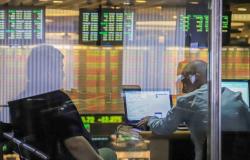Bloomberg — The main factors driving the remarkable resilience of the American consumer are losing steam at the same time, suggesting that the recent decline in household demand may be more than a one-time phenomenon.
Read More: Copa América: which are the National Teams with the most expensive shirts in the tournament?
Real disposable income has only increased modestly in the last year. The savings rate is now at a 16-month low as households have used up most of the extra money they accumulated during the pandemic. In turn, many Americans increasingly rely on credit cards and other sources of financing to support their spending.
These factors help explain why real spending – which excludes the impact of inflation – fell in April, with consumers spending less on cars, restaurants and recreational activities. With the labor market also cooling, companies like Best Buy Co. have noticed a shift in recent months as shoppers gravitate toward cheaper brands.
US Real Disposable Income Growth SlowsThe main driver of spending grew just 1% from a year ago in April(Bureau of Economic Analysis)
“The slowdown in the labor market will continue to limit income growth and will push families to moderate spending in a context of lower savings reserves and greater debt,” he says. Gregory Daco, chief economist at EY, in a note published on Friday. “Given increased price sensitivity, household spending momentum will gradually cool.”
The drop in consumer spending in April reported on Friday and the recent downward revision of the government’s estimate for first-quarter gross domestic product provide fairly compelling evidence that the U.S. economy is abandoning the surprisingly strong pace it set in 2023.
The latest data is also likely to reassure officials at the Federal Reserve, where a debate has emerged in recent weeks about whether its official interest rate – at its highest level in more than 20 years – was slowing the economy as much as as they expected.
The debate arose as a result of the strength shown by the American consumer in the last two years. While that helped the U.S. economy repeatedly defy recession forecasts, it baffled both Wall Street economists and Federal Reserve officials. The strong demand for labor, post-pandemic savings and considerable wage increases have contributed to this.
But as inflation becomes harder to control, forcing the Federal Reserve to keep borrowing costs high, the U.S. economy is finally beginning to slow. Demand for workers has fallen from its pandemic peaks, meaning employers are no longer raising wages as quickly. Wages and salaries advanced 0.2% in April, the smallest increase in five months, the personal consumption expenditures report showed.
The latest business results indicate that consumers are increasingly prioritizing essential products over large consumer discretionary items. And higher-income consumers are scaling back their purchases or looking for bargains, helping boost sales at Walmart Inc. (WMT) and discount retailer Dollar General Inc.
Employment report
Consumers are making “tough decisions with their budgets,” Best Buy CEO Corie Barry said on the first-quarter earnings call. The executive noted the changes in the macroeconomic environment since the e-tailer’s last quarterly report.
“Three months ago, there were several indicators that showed some favorability, including declining inflation, a persistently low unemployment rate, encouraging trends in consumer confidence and the beginning of a housing market rebound,” he said. Barry. “Since then, inflation remains high, mortgage rates are high and consumer confidence indices are trending downward.”
A new government employment report, due Friday, will provide more insight into the direction of the labor market. Federal Reserve policymakers will pay close attention to these numbers as they try to control inflation without bankrupting the economy.
From this point of view, the decline in consumer spending in April has probably contributed to the decline in inflation. However, it may also raise the question of how long the economy can last.
Andrew Hollenhorst and Veronica Clark, economists at Citigroup Inc., wrote after Friday’s PCE report: “Federal Reserve officials will view today’s report as showing some cooling in consumer spending, pointing to lower inflationary pressure.” “Our view of the American economy is not so optimistic.”
Read more at Bloomberg.com






